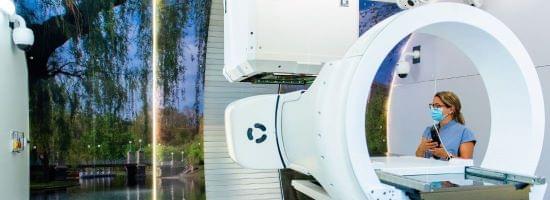Massachusetts General Hospital clinician-researchers work to define which patients can benefit most from advanced proton therapy for cancer.


In this video, I’m arguing that humans should become cyborgs and more about Transhumanism.
We are going to look at a few ideas which embrace the concept of artificial intelligence and cybernetics – the idea that we can fundamentally change the way that we think and interact with the world.
Neural Computing Interfaces will revolutionize the world. From aiding motor function recovery, to augmenting and transforming the future human users. In this video, we take a look at what good can come from this technology but also what dark horrors await this future.
In this video, we’ll talk about how future humans can survive the end of the universe. We’ll cover obstacles they must survive before facing the Death of the Universe.

I wrote a foreword for this awesome Sci-Fi book here: https://amzn.to/3aGrg0I
Get a Wonderful Person shirt: https://teespring.com/stores/whatdamath.
Alternatively, PayPal donations can be sent here: http://paypal.me/whatdamath.
Hello and welcome! My name is Anton and in this video, we will talk about new studies that present a scientific creation of artificial life.
Papers: https://linkinghub.elsevier.com/retrieve/pii/S0092867421002932
https://robotics.sciencemag.org/content/6/52/eabf1571
Old papers: https://science.sciencemag.org/content/329/5987/52?ijkey=844…f_ipsecsha.
https://pubmed.ncbi.nlm.nih.gov/14657399/
Press release and video/images: https://www.uvm.edu/uvmnews/news/team-builds-first-living-robots.
Images:
James Pelletier (MIT Center for Bits and Atoms and Department of Physics) and Elizabeth Strychalski (National Institute of Standards and Technology))
DOUGLAS BLACKISTON, Tufts University.
Otofrog, CC BY-SA 4.0
Charles Daghlian.
Universal Studios, NBCUniversal — Dr. Macro.
www.scientificanimations.com, CC0
IDKlab, CC0
Support this channel on Patreon to help me make this a full time job:
https://www.patreon.com/whatdamath.
Bitcoins to spare? Donate them here to help this channel grow!
32ygEA36irM9Dsqx2rXZmHQ9rj7ZoWDYWZ
Space Engine is available for free here: http://spaceengine.org.
Enjoy and please subscribe.
Twitter: https://twitter.com/WhatDaMath.


Covering interstellar distances in a human lifetime is far from easy. Going at 1 percent of the speed of light, it would take over 400 years to reach the closest star, and we have not been able to propel any spacecraft even close to that speed. But a new method aims to get to those speeds and maybe more – and it takes inspiration from the mighty albatross.
Chemical propulsion can be very useful in achieving high speeds pretty quickly, but there’s the drawback in that you need to carry the fuel with you, which means you need to be able to generate more thrust to shift the extra fuel and so on. It’s a huge issue when it comes to rocket science. A realistic alternative is ion propulsion, used to slowly and successfully maneuver the Dawn spacecraft, but it would take an equally long time to reach enough speed with such a steady but small acceleration.
Solar sails hold a more intriguing possible approach. Proposals such as the Breakthrough Starshot see lasers used to massively accelerate a spacecraft the size of a credit card to one-fifth the speed of light. But, you need to build a very powerful laser. A similar method using sunlight might also work, although not up to such a high speed.
For millennia, humans have been harnessing #microbes to produce everything from breads, to cheeses, to alcohol. Now these tiny organisms have produced another powerful revolution — the gene editing tool CRISPR. Rodolphe Barrangou, Ph.D., was working at the food company Danisco, where he was trying to produce yogurt lines resistant to contamination. In a series of groundbreaking experiments, he helped uncover what CRISPR was, how it worked, and why it could be so transformative.
Speaker Biography:
Rodolphe Barrangou, Ph.D., studies beneficial microbes, focusing on the occurrence and diversity of lactic acid bacteria in fermented foods and as probiotics. Using functional genomics, he has focused on uncovering the genetic basis for health-promoting traits, including the ability to uptake and catabolize non-digestible carbohydrates. He spent 9 years at Danisco-DuPont, characterizing probiotics and starter cultures, and established the functional role of CRISPR-Cas as adaptive immune systems in bacteria. At NC State, he continues to study the molecular basis for their mechanism of action, as well as developing and applying CRISPR-based technologies for genotyping, building immunity and genome editing.
Producers: Sarah Goodwin, Rebecca Ellsworth.
Cinematographer: Derek Reich.
Editor: Rebecca Ellsworth\
Graphics: Chris George, Maggie Hubbard.
Assistant Camera: Gray McClamrock.
Drone aerials: Travis Jack.
Supervising Editor: Regina Sobel.
Field Producer: Meredith DeSalazar.
Interview by: Adam Bolt.
Associate Producer: Shelley Elizabeth Carter.
Executive Producers: Shannon Behrman, Sarah Goodwin, Elliot Kirschner.
Except where otherwise noted, this work is licensed under.
http://creativecommons.org/licenses/by-nc-nd/4.0/
© 2007–2022 Science Communication Lab™. All rights reserved.
#biology #research
1 hour “interview” with ChatGPT.
Is OpenAI’s ChatGPT capable of having a coherent conversation? We find out in this special edition of the TWIML AI Podcast!
In this episode of the podcast, we are joined by ChatGPT, the latest and coolest large language model developed by OpenAl. In our conversation with ChatGPT, we discuss the background and capabilities of large language models, the potential applications of these models, and some of the technical challenges and open questions in the field. We also explore the role of supervised learning in creating ChatGPT, and the use of PPO in training the model. Finally, we discuss the risks of misuse of large language models, and the best resources for learning more about these models and their applications. Join us for a fascinating conversation with ChatGPT, and learn more about the exciting world of large language models.
The complete show notes for this episode can be found at twimlai.com/go/603.
🔔 Subscribe to our channel for more great content just like this: https://youtube.com/twimlai?sub_confirmation=1